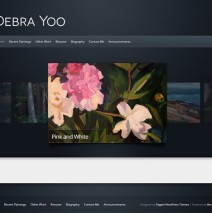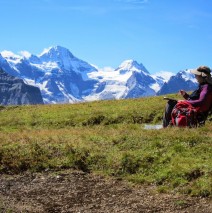Dropping the sack
Self-promotion has never been one of my skills, and I’m a little envious of artists to whom it comes more naturally. I find it difficult to write an artist’s statement, because my paintings ARE my statement as far as I’m concerned. In a time when lengthy and convoluted verbiage seems to have become almost a requirement for making art as well as writing about it, I fall into the dinosaur category. When I read a hefty socio-political statement of intention that suggests that the artist must be carrying the weight of the world on his/her shoulders upon entering the studio, I’m reminded of Robert DeNiro lugging that heavy sack full of armor uphill into the rain forest in “The Mission”. Drop it, Bob!
I think visual art (for the most part) is not a particularly effective route to motivating people towards social change. What is it good for? Another post, perhaps.
Read MoreFollowing my intuition
I’ve been working on a triptych (three canvases, each 30 x 24 inches) using studies of morning glories from this summer, and I’m finding it very involving. As with many paintings, the triptych idea just popped into my head, the only clear idea being that I knew which three studies would be developed further, and that each painting should be able to stand on its own as well as interconnect with the other two. After all, who knows if I’ll have the opportunity to display them as a triptych? I’ve been focusing on one canvas at a time, and recently I lined them up to see what was going on, or not going on. As is often the case, compositional relationships between the paintings that I hadn’t really thought too much about beforehand became very evident, which supports my belief that a lot of what goes on in painting happens just below the conscious level. Had I planned those relationships, I think the result would have looked contrived. Executed, in both senses of the word. More to follow.
Read MoreWebsite Updates
Thanks to Jay York | Photography and Jackie Webster of Small Web Solutions for their expertise and kind (as well as affordable) help in improving the quality of the images on this site. There are times when one can do it oneself, and this wasn’t one of them!
Read MoreWelcome to my new website
Welcome to my new website. Thank you for taking a look at my work, and please contact me if you have any questions.
Please check back to find out about any upcoming exhibitions, appearances, and new works.
Read MoreSwiss Alps series
For the past six months I’ve been working on a series of paintings of the Alps using studies I made on a trip to Switzerland last August. This is a plan that’s been simmering in my brain since my last trip there twenty years ago and my last exhibit of Swiss landscapes in 1988. Interesting the changes that twenty years bring: a little less energy, a lot more painting experience, and a willingness to trust my own knowledge more and care about the outcome much less.
Read MoreTrying new tools
It’s been over three years since my last post (maybe falling in love and getting married had something to do with it), but after my annual Monhegan stint, I’m reflecting about how my outdoor painting “kit” has changed. I’m trying out an aluminum Winsor & Newton Bristol easel as a replacement for my beloved half-box Jullian. Pros: It’s light, and I can easily carry it over my shoulder. If I hang my backpack from the top, the wind doesn’t blow it over. Con: I miss the waist-height drawer. However, by exercising a little ingenuity, along with the aid of heavy-dutyVelcro and binder clips, I have a small “shelf” (a single mesh silverware drawer divider) at waist height that’s enough for some solvent, charcoal, and a few brushes and other necessities. And with binder clips I was able to clip my folding brush holder to it so brushes are within reach. By the time I am too decrepit to scramble up and down the trails of Monhegan Island, I will have this completely figured out.
When one’s time is limited, efficiency becomes more and more important.
Read MoreGetting ready
Spring is actually here, so it’s time to start thinking about painting outdoors. For me, this means getting out the Jullian half-box and tuning it up: tightening screws, lubricating wing nuts, and applying a light coating of butcher’s wax to protect the surface. If you use a wooden easel, it’s wise not to tighten the wing nuts TOO much. A lengthy stay outdoors on a foggy day can cause the legs to swell (the easel’s, not yours) (but maybe yours too) and then the wing nuts will freeze up. I also like to line the drawer with some freezer paper or cut-up pieces of disposable palette paper, because when the inevitable paint tube leaks, it makes cleanup a lot easier. It’s a good time to sort through the studio and pull out half-used tubes of paint for use outdoors — why carry a full tube when half will do? My philosophy of outdoor painting is: think of all the awful things that have happened or could happen when you’re painting, and prepare for them!
Read More

